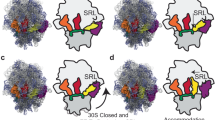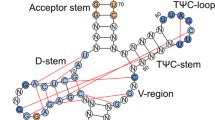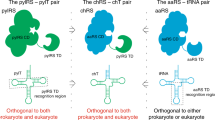Abstract
The binding of seven tRNA anticodons to their complementary codons on Escherichia coli ribosomes was substantially impaired, as compared with the binding of their natural tRNAs, when they were transplanted into tRNA2Ala. An analysis of chimeras composed of tRNA2Ala and various amounts of either tRNA3Gly or tRNA2Arg indicates that the presence of the parental 32-38 nucleotide pair is sufficient to restore ribosome binding of the transplanted anticodons. Furthermore, mutagenesis of tRNA2Ala showed that its highly conserved A32-U38 pair serves to weaken ribosome affinity. We propose that this negative binding determinant is used to offset the very tight codon-anticodon interaction of tRNA2Ala. This suggests that each tRNA sequence has coevolved with its anticodon to tune ribosome affinity to a value that is the same for all tRNAs.
This is a preview of subscription content, access via your institution
Access options
Subscribe to this journal
Receive 12 print issues and online access
$189.00 per year
only $15.75 per issue
Buy this article
- Purchase on Springer Link
- Instant access to full article PDF
Prices may be subject to local taxes which are calculated during checkout




Similar content being viewed by others
References
Yusupov, M.M. et al. Crystal structure of the ribosome at 5.5 A resolution. Science 292, 883–896 (2001).
Samaha, R.R., Green, R. & Noller, H.F. A base pair between tRNA and 23S rRNA in the peptidyl transferase centre of the ribosome. Nature 377, 309–314 (1995).
Kim, D.F. & Green, R. Base-pairing between 23S rRNA and tRNA in the ribosomal A site. Mol. Cell 4, 859–864 (1999).
Carter, A.P. et al. Functional insights from the structure of the 30S ribosomal subunit and its interactions with antibiotics. Nature 407, 340–348 (2000).
von Ahsen, U., Green, R., Schroeder, R. & Noller, H.F. Identification of 2′-hydroxyl groups required for interaction of a tRNA anticodon stem-loop region with the ribosome. RNA 3, 49–56 (1997).
Schnitzer, W. & von Ahsen, U. Identification of specific Rp-phosphate oxygens in the tRNA anticodon loop required for ribosomal P-site binding. Proc. Natl. Acad. Sci. USA 94, 12823–12828 (1997).
Feinberg, J.S. & Joseph, S. Identification of molecular interactions between P-site tRNA and the ribosome essential for translocation. Proc. Natl. Acad. Sci. USA 98, 11120–11125 (2001).
Phelps, S.S., Jerinic, O. & Joseph, S. Universally conserved interactions between the ribosome and the anticodon stem-loop of A site tRNA important for translocation. Mol. Cell 10, 799–807 (2002).
Fahlman, R.P., Dale, T. & Uhlenbeck, O.C. Uniform binding of aminoacylated transfer RNAs to the ribosomal A and P sites. Mol. Cell 16, 799–805 (2004).
Rose, S.J., III, Lowary, P.T. & Uhlenbeck, O.C. Binding of yeast tRNAPhe anticodon arm to Escherichia coli 30 S ribosomes. J. Mol. Biol. 167, 103–117 (1983).
Ogle, J.M. et al. Recognition of cognate transfer RNA by the 30S ribosomal subunit. Science 292, 897–902 (2001).
Sanbonmatsu, K.Y. & Joseph, S. Understanding discrimination by the ribosome: stability testing and groove measurement of codon-anticodon pairs. J. Mol. Biol. 328, 33–47 (2003).
Agris, P.F. Decoding the genome: a modified view. Nucleic Acids Res. 32, 223–238 (2004).
Kleina, L.G. et al. Construction of Escherichia coli amber suppressor tRNA genes. II. Synthesis of additional tRNA genes and improvement of suppressor efficiency. J. Mol. Biol. 213, 705–717 (1990).
Komine, Y. & Inokuchi, H. Importance of the G27–A43 mismatch at the anticodon stem of Escherichia coli tRNA(Thr2). FEBS Lett. 272, 55–57 (1990).
Raftery, L.A. & Yarus, M. Systematic alterations in the anticodon arm make tRNA(Glu)-Suoc a more efficient suppressor. EMBO J. 6, 1499–1506 (1987).
Hirsh, D. Tryptophan transfer RNA as the UGA suppressor. J. Mol. Biol. 58, 439–458 (1971).
Fahlman, R.P. & Uhlenbeck, O.C. Contribution of the esterified amino acid to the binding of aminoacylated tRNAs to the ribosomal P- and A-sites. Biochemistry 43, 7575–7583 (2004).
Ogle, J.M., Murphy, F.V., Tarry, M.J. & Ramakrishnan, V. Selection of tRNA by the ribosome requires a transition from an open to a closed form. Cell 111, 721–732 (2002).
Auffinger, P. & Westhof, E. Singly and bifurcated hydrogen-bonded base-pairs in tRNA anticodon hairpins and ribozymes. J. Mol. Biol. 292, 467–483 (1999).
Sprinzl, M. et al. Compilation of tRNA sequences and sequences of tRNA genes. Nucleic Acids Res. 26, 148–153 (1998).
Moazed, D. & Noller, H.F. Binding of tRNA to the ribosomal A and P sites protects two distinct sets of nucleotides in 16 S rRNA. J. Mol. Biol. 211, 135–145 (1990).
von Ahsen, U. & Noller, H.F. Identification of bases in 16S rRNA essential for tRNA binding at the 30S ribosomal P site. Science 267, 234–237 (1995).
Noller, H.F., Hoang, L. & Fredrick, K. The 30S ribosomal P site: a function of 16S rRNA. FEBS Lett. 579, 855–858 (2005).
Herr, A.J., Atkins, J.F. & Gesteland, R.F. Mutations which alter the elbow region of tRNA2Gly reduce T4 gene 60 translational bypassing efficiency. EMBO J. 18, 2886–2896 (1999).
Herr, A.J. et al. Analysis of the roles of tRNA structure, ribosomal protein L9, and the bacteriophage T4 gene 60 bypassing signals during ribosome slippage on mRNA. J. Mol. Biol. 309, 1029–1048 (2001).
Baranov, P.V., Gesteland, R.F. & Atkins, J.F. P-site tRNA is a crucial initiator of ribosomal frameshifting. RNA 10, 221–230 (2004).
Schultz, D.W. & Yarus, M. tRNA structure and ribosomal function. I. tRNA nucleotide 27–43 mutations enhance first position wobble. J. Mol. Biol. 235, 1381–1394 (1994).
Hou, Y.M. & Schimmel, P. A simple structural feature is a major determinant of the identity of a transfer RNA. Nature 333, 140–145 (1988).
McClain, W.H., Schneider, J., Bhattacharya, S. & Gabriel, K. The importance of tRNA backbone-mediated interactions with synthetase for aminoacylation. Proc. Natl. Acad. Sci. USA 95, 460–465 (1998).
Yarus, M. et al. The translational efficiency of tRNA is a property of the anticodon arm. J. Biol. Chem. 261, 10496–10505 (1986).
Lustig, F. et al. The nucleotide in position 32 of the tRNA anticodon loop determines ability of anticodon UCC to discriminate among glycine codons. Proc. Natl. Acad. Sci. USA 90, 3343–3347 (1993).
Claesson, C. et al. Glycine codon discrimination and the nucleotide in position 32 of the anticodon loop. J. Mol. Biol. 247, 191–196 (1995).
O'Connor, M. tRNA imbalance promotes -1 frameshifting via near-cognate decoding. J. Mol. Biol. 279, 727–736 (1998).
Auffinger, P. & Westhof, E. An extended structural signature for the tRNA anticodon loop. RNA 7, 334–341 (2001).
Dao, V. et al. Ribosome binding of DNA analogs of tRNA requires base modifications and supports the “extended anticodon”. Proc. Natl. Acad. Sci. USA 91, 2125–2129 (1994).
Cabello-Villegas, J., Winkler, M.E. & Nikonowicz, E.P. Solution conformations of unmodified and A(37)N(6)-dimethylallyl modified anticodon stem-loops of Escherichia coli tRNA(Phe). J. Mol. Biol. 319, 1015–1034 (2002).
Stuart, J.W. et al. Functional anticodon architecture of human tRNALys3 includes disruption of intraloop hydrogen bonding by the naturally occurring amino acid modification, t6A. Biochemistry 39, 13396–13404 (2000).
Shu, Z. & Bevilacqua, P.C. Isolation and characterization of thermodynamically stable and unstable RNA hairpins from a triloop combinatorial library. Biochemistry 38, 15369–15379 (1999).
Battle, D.J. & Doudna, J.A. Specificity of RNA-RNA helix recognition. Proc. Natl. Acad. Sci. USA 99, 11676–11681 (2002).
Pape, T., Wintermeyer, W. & Rodnina, M.V. Complete kinetic mechanism of elongation factor Tu-dependent binding of aminoacyl-tRNA to the A site of the E. coli ribosome. EMBO J. 17, 7490–7497 (1998).
Savelsbergh, A. et al. An elongation factor G-induced ribosome rearrangement precedes tRNA-mRNA translocation. Mol. Cell 11, 1517–1523 (2003).
Atkins, J.F. et al. Poking a hole in the sanctity of the triplet code: inferences for framing. in The Ribosome: Structure, Function, Antibiotics, and Cellular Interactions (eds. Garret, R.A. et al.) 369–383 (American Society for Microbiology Press, Washington, DC, 2000).
Yarus, M. Translational efficiency of transfer RNA's: uses of an extended anticodon. Science 218, 646–652 (1982).
Yusupova, G.Z., Yusupov, M.M., Cate, J.H. & Noller, H.F. The path of messenger RNA through the ribosome. Cell 106, 233–241 (2001).
Sampson, J.R. & Uhlenbeck, O.C. Biochemical and physical characterization of an unmodified yeast phenylalanine transfer RNA transcribed in vitro. Proc. Natl. Acad. Sci. USA 85, 1033–1037 (1988).
Wolfson, A.D. & Uhlenbeck, O.C. Modulation of tRNAAla identity by inorganic pyrophosphatase. Proc. Natl. Acad. Sci. USA 99, 5965–5970 (2002).
Acknowledgements
This work was supported by US National Institutes of Health Grant GM 37552 to O.C.U. We would also like to thank M. Saks for critically reading the manuscript.
Author information
Authors and Affiliations
Corresponding author
Ethics declarations
Competing interests
The authors declare no competing financial interests.
Rights and permissions
About this article
Cite this article
Olejniczak, M., Dale, T., Fahlman, R. et al. Idiosyncratic tuning of tRNAs to achieve uniform ribosome binding. Nat Struct Mol Biol 12, 788–793 (2005). https://doi.org/10.1038/nsmb978
Received:
Accepted:
Published:
Issue Date:
DOI: https://doi.org/10.1038/nsmb978
This article is cited by
-
Modifications of the human tRNA anticodon loop and their associations with genetic diseases
Cellular and Molecular Life Sciences (2021)
-
More than just scanning: the importance of cap-independent mRNA translation initiation for cellular stress response and cancer
Cellular and Molecular Life Sciences (2017)
-
Evolution of the Genetic Code by Incorporation of Amino Acids that Improved or Changed Protein Function
Journal of Molecular Evolution (2013)
-
Bases in the anticodon loop of tRNAAlaGGC prevent misreading
Nature Structural & Molecular Biology (2009)
-
A sequence element that tunes Escherichia coli tRNAAlaGGC to ensure accurate decoding
Nature Structural & Molecular Biology (2009)



